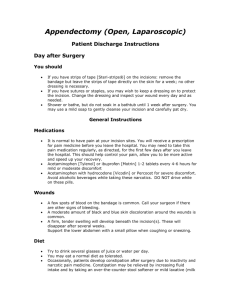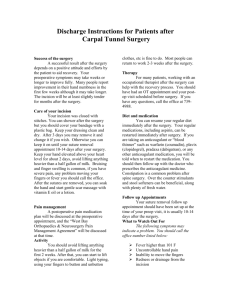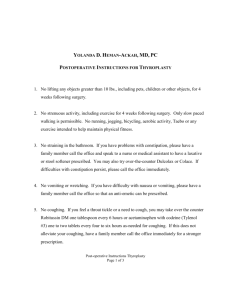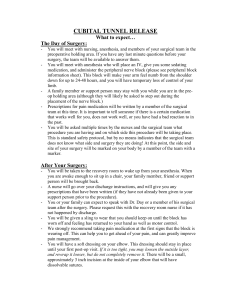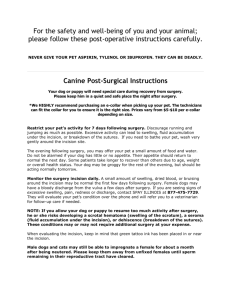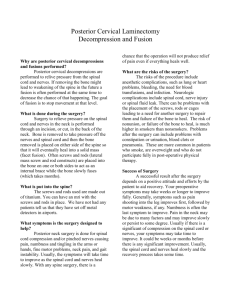Discharge Instructions for Patients after Lumbar Laminectomy or
advertisement
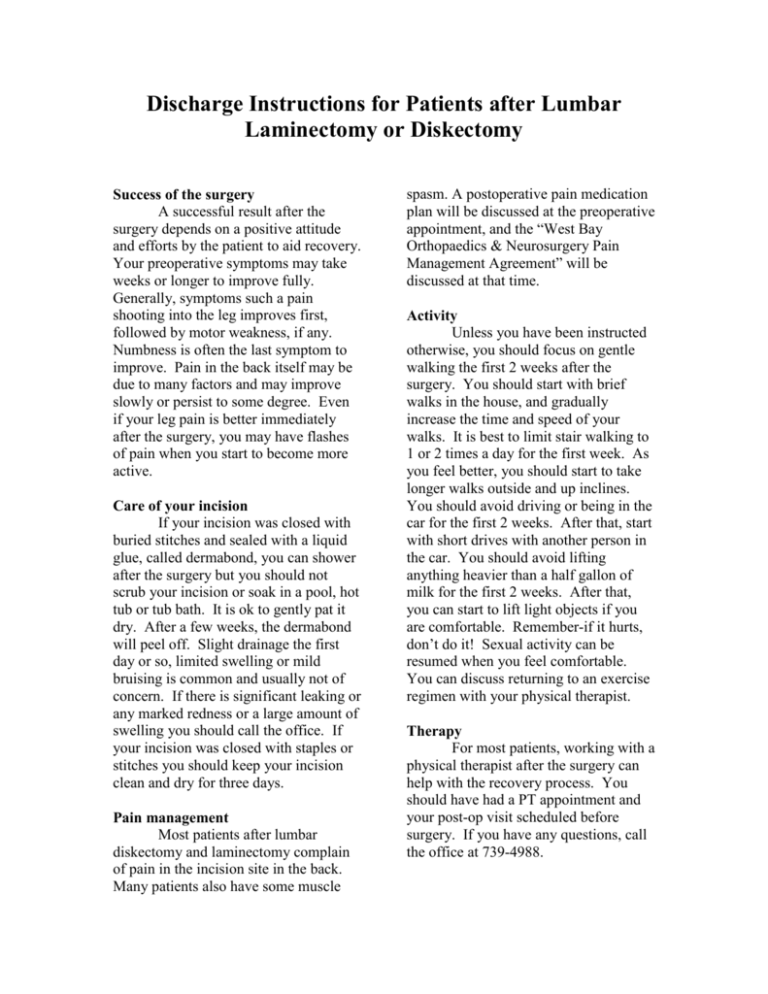
Discharge Instructions for Patients after Lumbar Laminectomy or Diskectomy Success of the surgery A successful result after the surgery depends on a positive attitude and efforts by the patient to aid recovery. Your preoperative symptoms may take weeks or longer to improve fully. Generally, symptoms such a pain shooting into the leg improves first, followed by motor weakness, if any. Numbness is often the last symptom to improve. Pain in the back itself may be due to many factors and may improve slowly or persist to some degree. Even if your leg pain is better immediately after the surgery, you may have flashes of pain when you start to become more active. Care of your incision If your incision was closed with buried stitches and sealed with a liquid glue, called dermabond, you can shower after the surgery but you should not scrub your incision or soak in a pool, hot tub or tub bath. It is ok to gently pat it dry. After a few weeks, the dermabond will peel off. Slight drainage the first day or so, limited swelling or mild bruising is common and usually not of concern. If there is significant leaking or any marked redness or a large amount of swelling you should call the office. If your incision was closed with staples or stitches you should keep your incision clean and dry for three days. Pain management Most patients after lumbar diskectomy and laminectomy complain of pain in the incision site in the back. Many patients also have some muscle spasm. A postoperative pain medication plan will be discussed at the preoperative appointment, and the “West Bay Orthopaedics & Neurosurgery Pain Management Agreement” will be discussed at that time. Activity Unless you have been instructed otherwise, you should focus on gentle walking the first 2 weeks after the surgery. You should start with brief walks in the house, and gradually increase the time and speed of your walks. It is best to limit stair walking to 1 or 2 times a day for the first week. As you feel better, you should start to take longer walks outside and up inclines. You should avoid driving or being in the car for the first 2 weeks. After that, start with short drives with another person in the car. You should avoid lifting anything heavier than a half gallon of milk for the first 2 weeks. After that, you can start to lift light objects if you are comfortable. Remember-if it hurts, don’t do it! Sexual activity can be resumed when you feel comfortable. You can discuss returning to an exercise regimen with your physical therapist. Therapy For most patients, working with a physical therapist after the surgery can help with the recovery process. You should have had a PT appointment and your post-op visit scheduled before surgery. If you have any questions, call the office at 739-4988. Diet and medication You can resume your regular diet immediately after the surgery. Your regular medications, including aspirin, can be restarted immediately after surgery. If you are taking an anticoagulant or “blood thinner” such as warfarin (coumadin), plavix (clopidogrel), pradaxa (dabigatran), or any other anticoagulant medication, you will be told when to restart the medication. You should then follow-up with the doctor who prescribes the anticoagulant medicine. Constipation is a common problem after spine surgery. Over the counter stimulants and stool softeners can be beneficial, along with plenty of fresh water. Work Most patients with lighter duty jobs return to work 4-6 weeks after the surgery. Patients whose jobs require heavy lifting may take longer. Your return to work will be discussed in your office follow up appointment. Follow up Appointments Your office follow up appointment should have been set up at the time of your preop visit. It is usually about 4 weeks after the surgery. Most patients will need another follow-up about 13 weeks after the surgery. What to Watch Out For These symptoms should cause you to call immediately or dial 911 to come to the emergency department Paralysis or inability to fully move your legs Severe chest pain, difficulty breathing Loss of control of your bowels and bladder The following symptoms may indicate a problem. You should call the office number listed below. Fever higher than 101 F Increasing back and/or leg pain Difficulty passing urine New numbness or change in symptoms from before surgery Redness or drainage from the incision Unusual headache, especially if it is much worse when you stand up Calf pain or swelling For questions after the surgery, please call 739-4988. After hours, the answering service will respond and page the doctor in an emergency.



